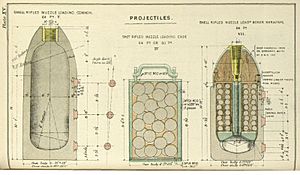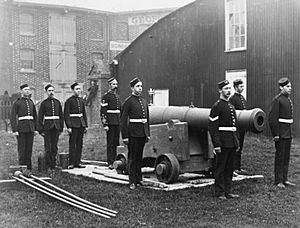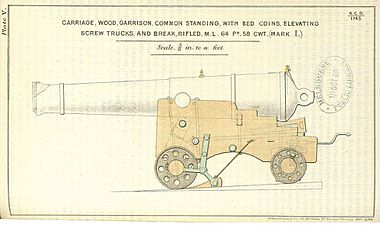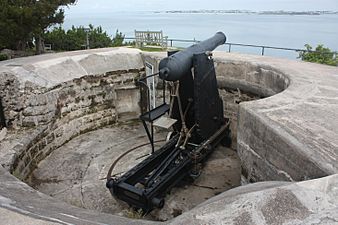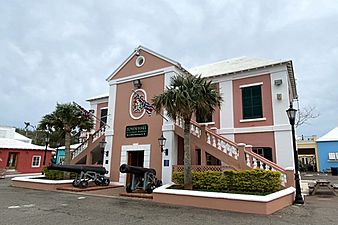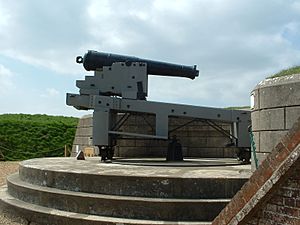RML 64-pounder 58 cwt facts for kids
Quick facts for kids Ordnance RML 64 pounder 58 cwt gun (converted) |
|
|---|---|
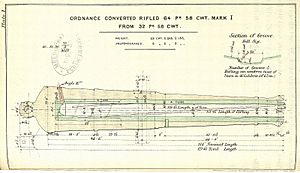
64 Pounder (58 cwt) RML gun barrel, diagram from handbook
|
|
| Type | Coast defence gun |
| Place of origin | United Kingdom |
| Service history | |
| In service | 1870–1902 |
| Used by | British Army British Colonies |
| Production history | |
| Designer | Lt Col William Dundas |
| Designed | 1847 |
| Manufacturer | Royal Gun Factory |
| Variants | One mark only |
| Specifications | |
| Mass | 6,496 pounds (2,947 kg) |
| Barrel length | 103.27 inches (2.623 m) (bore) |
|
|
|
| Shell | 64 pounds (29.03 kg) |
| Calibre | 6.3-inch (160.0 mm) |
| Carriage | Garrison carriage |
| Muzzle velocity | 1,230 feet per second (370 m/s) |
| Sights | Centre sighted |
The RML 64-pounder 58 cwt guns were powerful British cannons. They were called "rifled muzzle-loading" guns. This means they had grooves inside the barrel to make the shell spin. The shell was loaded from the front (muzzle). These guns were actually older 32-pounder cannons that were updated.
Contents
How the 64-Pounder Gun Was Designed
In the 1860s, Britain started using guns with grooves inside. These grooves made the shells fly straighter and farther. Britain had many old, smooth-barreled cannons. Making new gun barrels was very expensive. So, they decided to change the best old guns into new, rifled ones.
This update was called the Palliser conversion. It was a smart idea. A new, stronger metal tube was put inside the old cast-iron barrel. This made the gun much stronger. It was better to reinforce the gun from the inside out.
The 64-pounder gun started as a 32-pounder cannon. This old gun used to fire a 32-pound solid ball. To convert it, workers drilled out the inside of the old barrel. Then, they put in a new tube made of strong iron. This new tube was about 6.29 inches wide inside.
After the new tube was in place, they added three spiral grooves. These grooves made the shell spin as it left the gun. This spin helped the shell fly accurately. The gun was then tested by firing it. This test also helped the new tube fit even more tightly inside the old barrel.
Ammunition for the 64-Pounder Gun
The 64-pounder gun could fire three main types of ammunition. These types were used by other 64-pounder guns too. Even though many of these guns were used to defend coasts, they weren't very good against heavily armored ships.
- Common shell: This was used to attack buildings or forts.
- Shrapnel shell: This shell was filled with small balls. It was used against groups of soldiers or cavalry (soldiers on horseback).
- Case shot: This was used for close-range fighting against targets that weren't armored.
To fire the gun, a small copper tube was put into a hole at the back of the gun. A rope, called a lanyard, was attached to this tube. When the lanyard was pulled, the tube would spark. This spark would ignite a bag of black powder inside the gun. The burning powder created a lot of gas, pushing the shell out.
Different types of fuses could be used with the shells. Some fuses made the shell explode at a certain time or distance. Others made it explode when it hit something. Gunners could fire about one round every three minutes.
Where the 64-Pounder Guns Were Used
These guns were made to be used both on land and at sea. However, they quickly became old-fashioned for naval use. They were used widely across the British Empire. This included places like Australia and Bermuda.
Some 64-pounder guns were used by the navy in Australia. For example, they were on a ship called the HMVS Nelson. The gunners on this ship practiced using both old smoothbore shells and new rifled shells. This helped them be ready for anything.
On land, the ways these guns were mounted varied a lot. Some guns were on simple wooden stands. Others were on more complex iron mounts. Some were even on special mounts that could hide the gun after it fired. These were called disappearing gun carriages.
Some mounts were designed to protect the gun crew. Many guns were placed on open platforms for training. Soldiers would practice firing and moving the guns. By 1902, these guns were no longer useful for defending coasts. Many were then taken apart or thrown away.
Gallery
-
Gun on Moncrieff disappearing mount, at Scaur Hill Fort, Bermuda
-
Two guns on metal carriages at the Town Hall of St. George's Town, facing onto the Queen's Square
See also
- RML 64 pounder 64 cwt gun the equivalent new design frontline 64-pounder gun
Surviving examples
- Gun number 70, dated 1871 on wooden traversing carriage, Royal Citadel, Plymouth, Devon, UK
- Gun number 101, dated 1873 at Royal Armouries, Fort Nelson, Hampshire, UK
- Gun number 188, dated 1873 on wooden traversing carriage, Royal Citadel, Plymouth, Devon, UK
- Gun number 220, dated 1873 on wooden traversing carriage, Royal Citadel, Plymouth, Devon, UK
- Gun number 225, dated 1873 on wooden traversing carriage, Royal Citadel, Plymouth, Devon, UK
- Gun number 237 dated 1874, one of a pair located in Digby, Nova Scotia, Canada
- Gun number 255, dated 1873 on wooden traversing carriage, Royal Citadel, Plymouth, Devon, UK
- Gun number 327 dated 1874 – one of a number of examples on iron depression carriages, Gibraltar – from Flickr
- Gun number 401, dated 1874, Prince Edward Battery, Prince Edward Island, Canada
- Gun number 414, dated 1874, Prince Edward Battery, Prince Edward Island, Canada
- Gun number 420, dated 1874, Prince Edward Battery, Prince Edward Island, Canada
- Gun number 448, dated 1874, Prince Edward Battery, Prince Edward Island, Canada
- Gun number 507, dated 1875 on wooden traversing carriage, Royal Citadel, Plymouth, Devon, UK
- Gun number 550, dated 1876 on wooden garrison standing carriage, Royal Citadel, Plymouth, Devon, UK
- Gun number 577, dated 1875 on wooden garrison standing carriage, Royal Citadel, Plymouth, Devon, UK
- Gun number 581, dated 1876 at Royal Armouries, Fort Nelson, Hampshire, UK
- Gun number 611, dated 1876 on wooden traversing carriage, Royal Citadel, Plymouth, Devon, UK
- Gun number 615, dated 1877 at Fort Cumberland, New Brunswick, Canada
- Gun number 619, dated 1875 at Royal Armouries, Fort Nelson, Hampshire, UK
- Gun number 622, dated 1875 on wooden garrison standing carriage, Royal Citadel, Plymouth, Devon, UK
- Gun number 774, dated 1877 preserved at Scaur Hill Fort, Bermuda
- Gun number 798, dated 1877 at King's Square, St George Bermuda
- Several guns from HMVS Nelson can be found scattered around the State of Victoria, Australia in public areas, as well as two on military premises at Victoria Barracks, Melbourne, and one at Fort Queenscliff.


